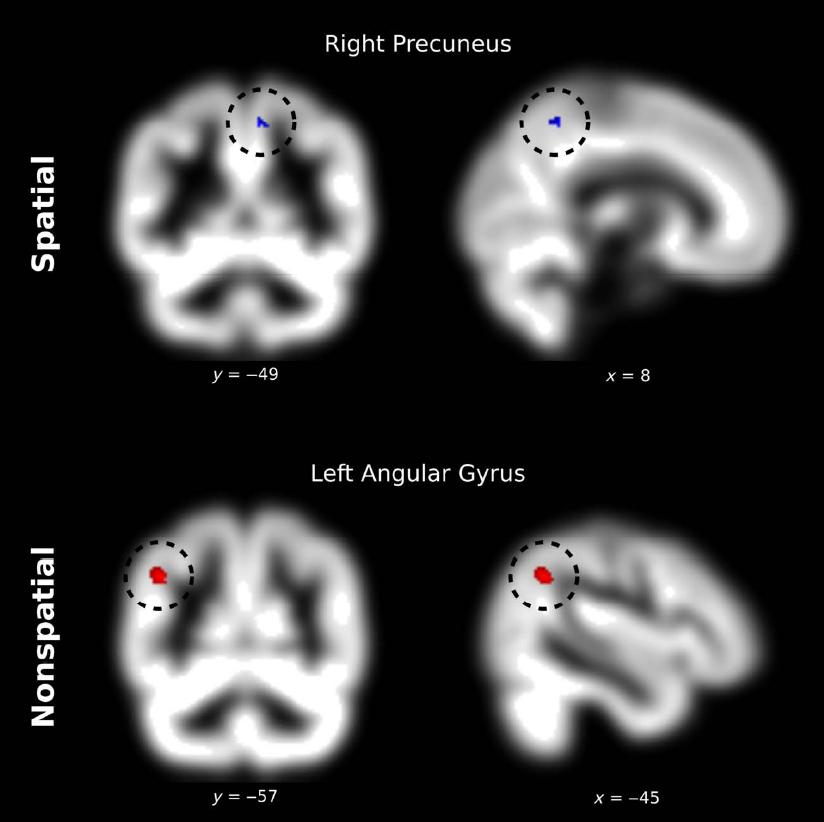How we process numbers is revealed in our brain structure
December 24, 2013

Relative changes in gray-matter volume (credit: Donders Institute, University of Nijmegen)
For a long time, scientists thought that everyone processed numbers predominantly in a spatial way (low to high numbers visualized as left to right).
More recently, several studies have shown associations between numbers and non-spatial representations of magnitude, such as physical size, grip opening, object graspability, tactile sensation, force (against a button, for example), and luminosity.
Gray-matter volume differences
A study by Florian Krause from the Donders Institute in Radboud University Nijmegen in the Netherlands, just published in the Journal of Cognitive Neuroscience, has now found that these individual differences are related to specific brain structures.
In MRI scans of test subjects, he discovered differences in gray-matter volume in two specific locations:
- Spatially oriented brains have an above-average grey matter volume in the right precuneus, a small area of the brain associated with processing visual-spatial information.
- Non-spatially oriented brains have more grey matter in the left angular gyrus, an area associated with semantic and conceptual processing.
Importantly, participants coupled the spatial response as well as the force response to the size of the presented number, as they responded faster with a left or soft press for small numbers and with a right or hard press for large numbers. Krause worked out those couplings for each subject, and compared the scores with the information from their brain scan.
At present, math is largely taught on the basis of a spatial number processing. “People with a non-spatial representation of numbers would probably benefit from a different approach to maths teaching,” says Krause. “It is possible to let pupils experience the size of numbers in a non-spatial way. This could involve expressing numbers with your body while doing simple arithmetics, for example.” Krause is planning several new studies to explore the scientific basis of methods like these in more detail.
So how does this relate to reports of how Einstein, Feynman, and others used kinesthetic imaging, music, sounds, and other methods to represent physics principles?
Abstract of Journal of Cognitive Neuroscience paper
A dominant hypothesis on how the brain processes numerical size proposes a spatial representation of numbers as positions on a “mental number line.” An alternative hypothesis considers numbers as elements of a generalized representation of sensorimotor-related magnitude, which is not obligatorily spatial. Here we show that individuals’ relative use of spatial and nonspatial representations has a cerebral counterpart in the structural organization of the posterior parietal cortex. Interindividual variability in the linkage between numbers and spatial responses (faster left responses to low numbers and right responses to high numbers; spatial–numerical association of response code effect) correlated with variations in gray matter volume around the right precuneus. Conversely, differences in the disposition to link numbers to force production (faster soft responses to low numbers and hard responses to high numbers) were related to gray matter volume in the left angular gyrus. This finding suggests that numerical cognition relies on multiple mental representations of analogue magnitude using different neural implementations that are linked to individual traits.
(¯`*• Global Source and/or more resources at http://goo.gl/zvSV7 │ www.Future-Observatory.blogspot.com and on LinkeIn Group's "Becoming Aware of the Futures" at http://goo.gl/8qKBbK │ @SciCzar │ Point of Contact: www.linkedin.com/in/AndresAgostini
 Washington
Washington